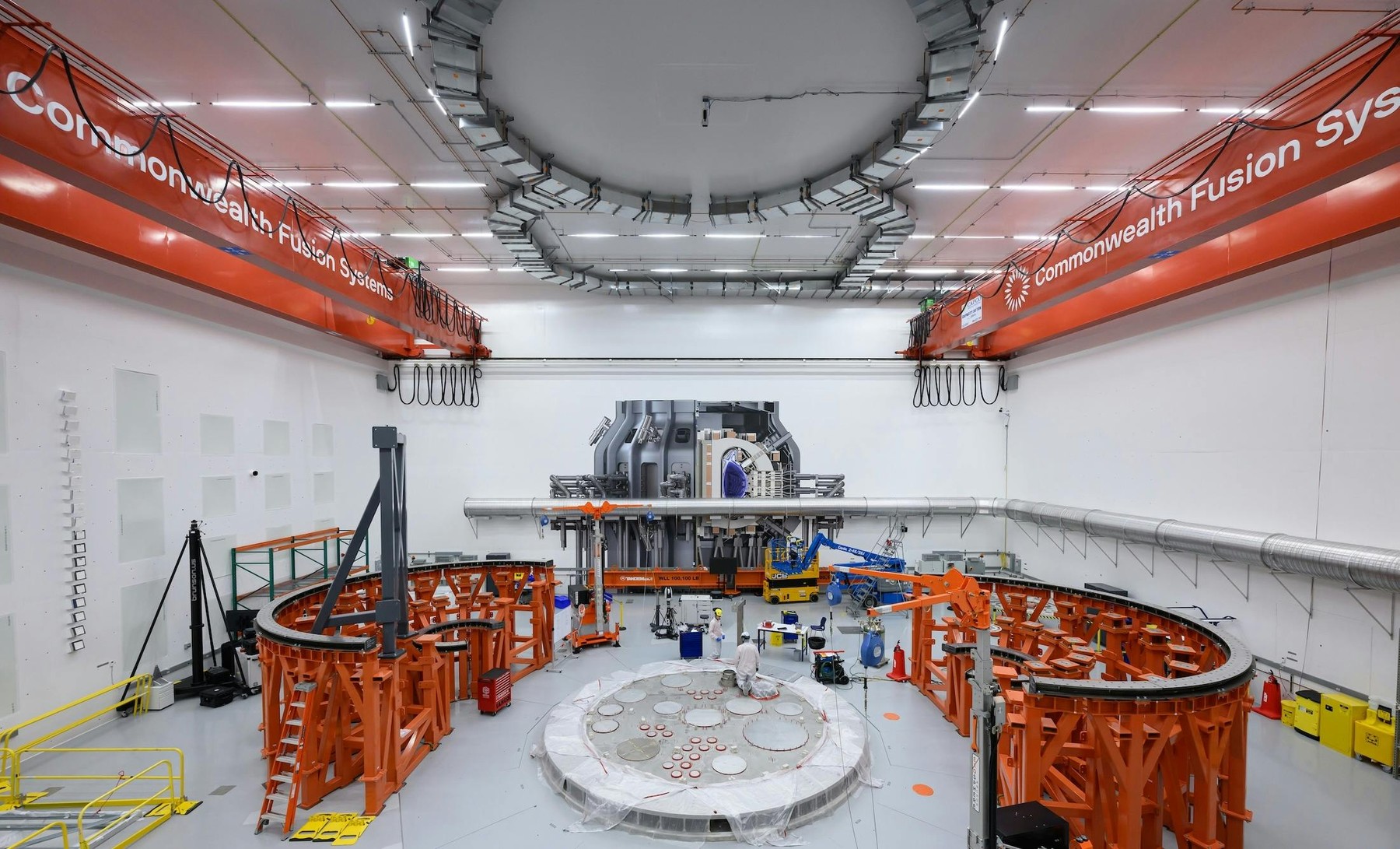Welcome to Climate Tech Pulse, your daily dose of market intelligence helping fuel the fight against climate change. From groundbreaking investments to cutting-edge research, we’re bringing you the latest in climate tech that’s shaping our future.
Don’t miss out on tomorrow’s climate solutions – subscribe now to stay ahead of the curve! https://lnkd.in/dwr7B9XJ
Today’s newsletter:
🔝Today’s Top Story: In a strategic move to strengthen America’s clean energy future, the U.S. Department of Energy and Michigan’s Competitiveness Fund have awarded Mitra Chem up to $125 million.

📊 Today’s Data Point: Record-Breaking Fires in South America.
🌳 Climate Insider Intelligence: Exploring the Next Frontier of Climate Tech in Southeast Asia.
U.S. Clean Energy Milestone: Mitra Chem Secures $125M to Launch First Domestic Lithium Iron Phosphate Battery Facility
Image Credit: U.S. Department of Energy
Major Investment in U.S. Battery Manufacturing
In a strategic move to strengthen America’s clean energy future, the U.S. Department of Energy and Michigan’s Competitiveness Fund have awarded Mitra Chem up to $125 million. This funding will enable the establishment of the first mass production facility for lithium iron phosphate cathodes in North America, located in Muskegon, Michigan. This project, aligned with the Inflation Reduction Act, marks a critical step toward enhancing the U.S.’s leadership in electric vehicle (EV) battery manufacturing, energy storage systems, and defense applications.
Partnership and Technological Innovation
Mitra Chem’s new facility will leverage advanced technologies, including a machine learning-driven acceleration platform, to revolutionize battery material production at unprecedented speeds. Partnering with Sun Chemical, a company with a century of experience in particle engineering and large-scale manufacturing, Mitra Chem aims to set new industry standards in cathode active materials. This collaboration not only boosts innovation but also positions the U.S. as a global leader in battery technology.
National Security and Economic Impact
By localizing the production of lithium iron phosphate, a material predominantly sourced from China, this initiative addresses national security concerns related to global supply chain dependencies. The project is expected to create hundreds of high-skilled jobs in Michigan while nearly doubling the U.S.’s LFP production capacity by 2027. As the facility scales, it could supply batteries for millions of electric vehicles annually, significantly advancing America’s clean energy goals and reducing reliance on foreign competitors. Read More
Quote of the Day
“This award selection represents a pivotal moment for the entire U.S. battery industry,” said Mitra Chem CEO Vivas Kumar. “By bringing advanced battery production to American soil we’re securing our energy future and positioning the U.S. at the forefront of the global electric vehicle revolution. The support from the DOE and Michigan, and our collaboration with Sun Chemical, will accelerate Mitra’s mission to revolutionize next generation battery production.”
Significance: Vivas Kumar highlights the importance of localizing advanced battery production, which reduces U.S. dependence on foreign supply chains, particularly from China, and enhances national energy security.
Industry Leadership: By bringing battery manufacturing to the U.S., the initiative positions the country as a leader in the global electric vehicle (EV) revolution, a critical industry for future economic and environmental success.
Innovation Acceleration: The collaboration between Mitra Chem, the DOE, Michigan, and Sun Chemical is portrayed as a catalyst for innovation, accelerating the development of next-generation battery technologies and solidifying the U.S.’s competitive edge.
Strategic Importance: The quote highlights that this project is not just about manufacturing but about revolutionizing the industry, implying long-term strategic importance for the U.S. in the global clean energy landscape.
Market Movers
- Phlair (formerly Carbon Atlantis) raised €14.5 million to scale its innovative, low-cost Direct Air Capture technology, with backing from leading investors and a €2.5 million EU grant, marking a significant step toward commercializing its first plants by 2025 to meet the growing demand from companies like Shopify and Stripe. Read More
- Nvidia is partnering with UAE-based G42 to establish a climate technology lab in Abu Dhabi, leveraging Nvidia’s Earth-2 platform to enhance weather forecasting accuracy and drive advancements in climate AI, emphasizing both companies’ commitment to environmental sustainability. Read More
- Lightyear secured over €10 million in its largest funding round since restarting, enabling the expansion of its expert team to position itself as a leading supplier of solar mobility technologies to global automotive companies. Read More
Tech Spotlight
AI-Driven Urban Electrification for Enhanced Power Grid Stability
Source: Korea Institute of Energy Research (KIER) Press Release, September 2024
Overview
A joint research team from the Renewable Energy System Laboratory and the Energy ICT Research Department at the Korea Institute of Energy Research (KIER) has developed advanced AI-driven technologies to support “Urban Electrification.” This concept leverages renewable energy sources, such as building-integrated solar technology, to transform urban energy systems and reduce reliance on fossil fuels. While relatively new in South Korea, urban electrification is a key strategy in the U.S. and Europe for achieving carbon neutrality and sustainable urban environments.
Commercial Viability
Implementation Strategy:
The research team developed an AI-based energy management algorithm designed to address the challenges of power grid stability in urban electrification. This algorithm was implemented into a system demonstrated in a real-world, community-scale environment, achieving significant improvements in energy efficiency and grid stability.
Cost Efficiency:
The AI-driven system reduced electricity costs by 18% compared to conventional methods. The system optimizes energy sharing between buildings, manages peak demand, and enhances the stability of the power grid, even during extreme weather events known as Low-Probability High-Impact Events (LPHI).
Technical Viability
System Testing:
The system’s effectiveness was validated through real-world application, achieving an energy self-sufficiency rate of 38% and an energy self-consumption rate of 58%. This represents a marked improvement over conventional systems, which typically achieve only 20% self-sufficiency and 30% self-consumption.
Research Milestone:
The research findings, published in the journal *Sustainable Cities and Society*, highlight the potential of AI in managing complex variables such as weather patterns and human behavior to stabilize urban power grids. The study emphasized the critical impact of LPHI events on grid stability, which occur on average 1.7 days per year but can cause substantial disruptions.
Environmental Viability
Emission Reduction:
By optimizing energy use and enhancing the stability of renewable energy systems, the AI-driven technology offers a sustainable solution for urban environments. It supports the reduction of carbon emissions by decreasing reliance on fossil fuels and improving the efficiency of renewable energy integration into the grid.
Scaling Potential
Real-World Application:
The system was successfully demonstrated in an environment consuming 107 megawatt-hours (MWh) annually, a scale significantly larger than previous simulation-based studies. This achievement underscores the system’s potential for widespread adoption in urban settings, paving the way for scalable urban electrification solutions.
Long-Term Implications
Industry Impact:
The development of this AI-driven system represents a critical advancement in the field of urban electrification. It sets a new standard for managing renewable energy variability and grid stability, potentially driving further innovations in AI and renewable energy technologies.
Challenges Ahead:
While the research demonstrates significant potential, scaling this technology to diverse urban environments presents challenges. These include managing the financial costs of widespread implementation and addressing the unique energy demands of different urban areas. Further research and investment will be needed to overcome these hurdles and fully realize the benefits of urban electrification. Read More
Policy Pulse
This section includes global updates on climate change policy, governance and regulation.
The World Nuclear Association issues joint communiqué at Roadmaps to New Nuclear.
At the recent “Roadmaps to New Nuclear” conference in Paris, representatives from the nuclear industry across OECD nations reaffirmed their commitment to expanding nuclear capacity in line with the COP28 Declaration to Triple Nuclear, while also urging the World Bank to resume financing for nuclear projects, highlighting the critical need for collaborative government-industry efforts to achieve ambitious clean energy goals.
Why it Matters: This development matters because it signals a renewed and coordinated push for nuclear energy as a vital component in meeting global clean energy targets and addressing climate change, emphasizing the importance of financial support and international collaboration. Read More
European Green Deal: a double-edged sword for global emissions.
An analysis led by Klaus Hubacek published in Nature Sustainability reveals that while the European Union’s Green Deal aims for carbon neutrality by 2050, it may inadvertently increase carbon emissions outside the EU by more than double the reductions achieved within its borders, highlighting significant gaps in the policy’s effectiveness on a global scale.
Why it Matters: This matters because it highlights the need for comprehensive climate policies that address not only domestic emissions but also the global impacts of emissions shifts, ensuring that efforts to combat climate change do not inadvertently exacerbate the problem elsewhere. Read More
Today’s Climate Data Point
Record-Breaking Fires in South America: A Worsening Trend Amidst Climate Change
Source: World Resources Institute (WRI), Global Forest Watch
A concerning surge in fires across South America, particularly in the Amazon rainforest, highlights the dual threats of climate change and deforestation. With fire alerts in the Amazon region up 79% compared to historical averages, the situation underscores the urgent need for comprehensive strategies to combat this escalating crisis.
Report Focus:
Research Emphasis: The current fire outbreaks reflect not only immediate climate conditions but also long-term trends exacerbated by human activity. A robust El Niño event has intensified fire risks, compounding the effects of ongoing deforestation.
Key Findings:
- Bolivia: Over 29,000 fire alerts recorded in 2024, marking the worst fire season in two decades. Approximately 90% of these alerts occurred after July 1, with 70% in primary forests, vital for biodiversity and carbon storage. Fire incidents have increased fivefold compared to two decades ago.
- Brazil: Home to 60% of the Amazon, Brazil has reported over 47,000 fire alerts in 2024, more than double the seasonal average. Fires have consumed over 11 million hectares, akin to the size of Guatemala, with only one year (1987) having a larger burned area by this time. High deforestation rates have turned Brazilian forests into net carbon sources.
- Peru: With the second-largest section of the Amazon, Peru has seen over 450 fire alerts this year, more than double the average. Primary forests account for 61% of these fire occurrences, emphasizing the urgent need for protective measures.
Implications:
- Climate Feedback Loop: Fires in the Amazon are primarily human-caused, often linked to land clearing for agriculture. This deforestation contributes to regional climate changes, leading to severe droughts that increase fire susceptibility. The interplay between rising temperatures and altered rainfall patterns heightens the risk of expansive fires.
- Carbon Emissions: The fires release significant amounts of CO2 and pollutants, further exacerbating climate change. Recovery of lost carbon can take decades, emphasizing the long-term impact of these events.
Future Directions:
- Policy Action: Addressing the root causes of forest fires is critical. Effective policies must focus on both immediate firefighting efforts and the broader strategies needed to mitigate deforestation and promote sustainable land management.
Conclusion:
As South American nations grapple with unprecedented fire seasons, concerted efforts are essential to tackle the direct and indirect drivers of these fires. Without immediate action, the region risks compounding its climate challenges and compromising critical ecosystems. Read More
In Other News
This section covers notable news highlights in climate tech.
- Climate Insider has partnered with 🌏 The Atlas Capital & Climate Tech Coalition to cover The Climate Tech Investors Summit in New York City on September 24-25, 2024, an event focusing on funding and advancing climate solutions through discussions and networking with industry leaders and investors. Learn More
Climate Insider Intelligence: Exploring the Next Frontier of Climate Tech in Southeast Asia
In this article, explore the booming climate tech investment landscape in Southeast Asia—a region rich with opportunities.
Discover how rapid economic growth, government initiatives, and innovative technologies are transforming this region into a hotspot for sustainable solutions.With increasing attention from global investors, Southeast Asia is emerging as the next frontier for climate tech. Dive into our latest analysis to uncover the trends, opportunities, and challenges that define this dynamic market. Read More








